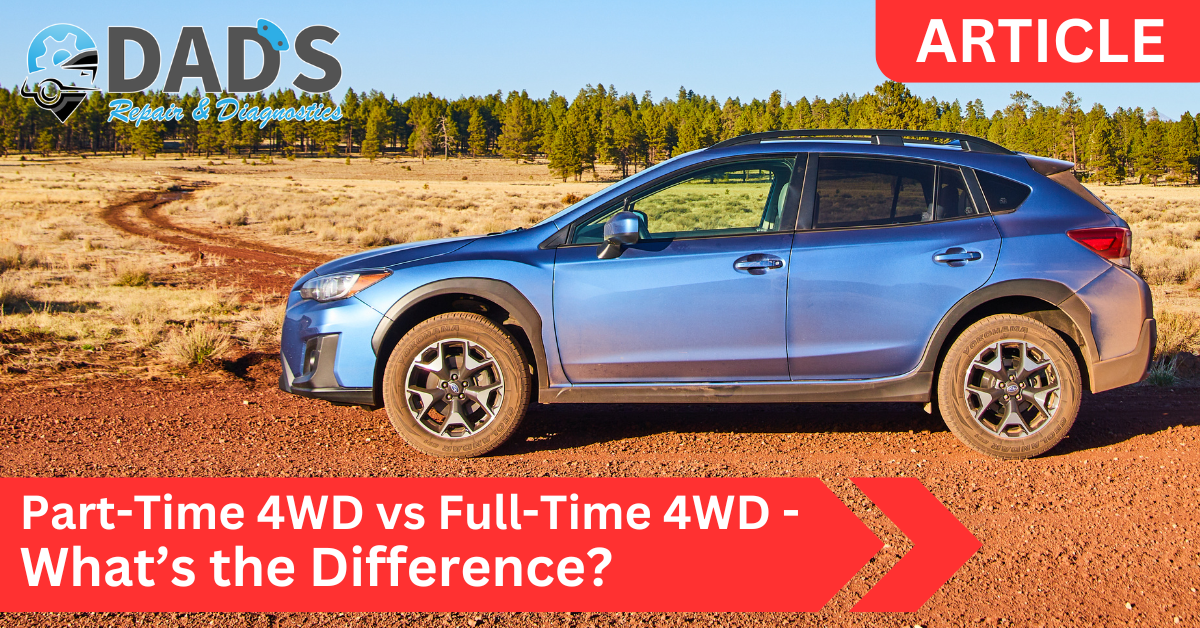Four-wheel-drive vehicles are built for confidence — confidence in bad weather, on rough terrain, and in situations where you need every tire gripping the ground. But if you’ve ever wondered what makes Part-Time 4WD different from Full-Time 4WD, or how AWD compares, you’re not alone.
At DADS Auto Repair in Madera, CA, we work on all types of drivetrains — from pickup trucks and Jeeps to modern SUVs — and one thing we hear often is, “What’s really the difference between these systems?” Understanding how 4WD works not only helps you use it correctly, but also helps you maintain it properly and avoid costly repairs to the transfer case or differential.
Let’s dig into what separates these systems, how they work, and which one is right for the way you drive.
What 4WD Really Means
Before we get into the types, let’s start with the basics. 4WD — short for four-wheel drive — means power can be sent to all four wheels at the same time. That’s different from traditional two-wheel drive vehicles, which only send power to either the front or rear wheels.
The goal of 4WD is simple: traction. When you’re driving on loose dirt, gravel, snow, or mud, having all four wheels working together gives you better control and grip. But how your vehicle achieves that depends on whether it’s part-time or full-time 4WD — and that’s where the real differences come in.
What Is Part-Time 4WD?
Most trucks and off-road SUVs use Part-Time 4WD. This system is designed to let the driver choose when to engage all four wheels. Under normal driving conditions, the vehicle operates in two-wheel drive — typically powering the rear wheels.
When the road gets slippery or you head off-road, you can switch into 4WD using a lever, dial, or button on the dash. This locks the front and rear driveshafts together, forcing both axles to turn at the same speed.
That locked connection gives you incredible traction — great for climbing steep hills, crawling over rocks, or getting out of a muddy ditch. However, there’s a catch: it’s not meant for dry pavement. Because both axles are locked together, turning corners on solid ground causes binding and stress in the transfer case and differential. Over time, that stress can cause major drivetrain damage.
Drivers sometimes call this “driveline windup,” and it’s one of the most common mistakes we see at DADS Auto Repair. People forget to switch back out of 4WD after leaving dirt or snow, then wonder why the truck feels like it’s fighting itself on the road.
When to Use Part-Time 4WD
Part-Time 4WD is ideal for:
- Off-roading or trail driving
- Snowy or muddy conditions
- Loose gravel or sand
- Rural dirt roads during rain
If your vehicle has selectable modes like 4H (high) and 4L (low), use 4H for slippery pavement or light off-road terrain, and 4L for slow, rugged driving where torque matters more than speed.
The key takeaway: only use 4WD when the road surface allows some slippage. Otherwise, you’re stressing parts that aren’t designed to handle the difference in wheel speeds.
What Is Full-Time 4WD?
Unlike part-time systems, Full-Time 4WD (sometimes called permanent 4WD) keeps all four wheels engaged at all times. These systems use a center differential inside the transfer case to let the front and rear axles spin at different speeds. That means you can safely drive in 4WD on dry pavement without binding up the drivetrain.
It’s the same concept as the differentials in your front and rear axles — which allow the left and right wheels to rotate at different speeds while turning. The center differential does the same thing between the front and rear wheels.
Full-time systems often include a lock mode that essentially turns it into part-time 4WD. When engaged, the center differential locks up, giving you maximum traction in deep snow, mud, or sand. Once you’re back on regular pavement, you simply unlock it to restore smooth handling.
When to Use Full-Time 4WD
Full-time 4WD is best for drivers who face changing road conditions — like wet mornings, dirt driveways, or winter mountain trips — but don’t want to think about switching in and out of 4WD. It’s convenient, always ready, and designed for safety and stability year-round.
Vehicles like certain Land Cruisers, Subarus, and modern 4×4 SUVs often use full-time systems for that reason. They give you traction when you need it and comfort when you don’t have to think about it.
How AWD Fits Into the Mix
You’ll also hear about AWD (All-Wheel Drive), which is sometimes confused with 4WD. While both send power to all four wheels, AWD systems are fully automatic — there’s no 4WD switch or lever.
AWD relies on sensors and computer-controlled differentials to distribute power wherever traction is needed most. In normal driving, most AWD systems primarily power one axle (usually the front) and only send power to the other when the computer detects slipping.
AWD is perfect for paved roads, rain, and light snow. It’s the best system for drivers who never plan to off-road but want the security of extra traction in bad weather. However, AWD lacks the low-range gearing found in traditional 4WD, so it’s not ideal for rock crawling or serious mud.
The Role of the Transfer Case and Differentials
No matter which system you have — Part-Time 4WD, Full-Time 4WD, or AWD — the transfer case is the heart of it all. It’s what divides engine power between the front and rear axles. Inside, gears and chains work with clutches or differentials to engage or disengage 4WD.
Your differentials (front, center, and rear) make sure the wheels can spin at different speeds when turning. Without them, every corner would feel like dragging your tires sideways.
Both components need regular service to stay reliable. The gear oil inside them breaks down over time, and running them low or dirty can cause grinding, whining, or complete failure. At DADS Auto Repair, we recommend inspecting and changing transfer case and differential fluids every 30,000–50,000 miles, depending on how you drive.
Maintenance Tips for Your 4WD System
Modern 4WD systems are strong, but they’re not invincible. Whether you drive a weekend trail rig or an all-season SUV, a few simple habits will keep your 4WD system working for years.
- Engage 4WD occasionally. Even in dry weather, engaging it for a few miles every month keeps internal parts lubricated and prevents seals from drying out.
- Check fluid levels regularly. The transfer case and differentials rely on clean gear oil — leaks can go unnoticed until major damage occurs.
- Listen for noises. Clunking, grinding, or whining when turning could mean worn differential gears or low fluid.
- Inspect CV axles and U-joints. These are the unsung heroes of your 4WD system. Torn boots or worn joints can cause vibration and power loss.
- Avoid mixing tire sizes. Different tire diameters can upset your 4WD system and strain your transfer case or differentials.
Keeping these parts in shape ensures your 4WD engages smoothly and performs when you need it most.
Choosing the Right System for You
If you do a lot of off-roading, tow heavy loads, or live on dirt roads, Part-Time 4WD gives you the control and durability you need — just remember to disengage it on dry pavement.
If your main concern is safety and stability on unpredictable roads — maybe you take trips up to Yosemite or hit foggy Highway 41 on wet mornings — Full-Time 4WD or AWD is probably the better fit. It’s seamless, smart, and ready whenever traction slips.
No matter which system you drive, proper maintenance is key. At DADS Auto Repair in Madera, our technicians are experts at servicing transfer cases, differentials, and all types of 4WD systems. We know the warning signs, the wear patterns, and how to keep everything running smoothly before problems start.
Trust DADS Auto Repair with Your 4WD System
Your vehicle’s 4WD system is built for strength, but it still depends on proper care to keep it that way. If you notice unusual noises, delayed engagement, or grinding when switching between 2WD and 4WD, it’s time for a check-up.
At DADS Auto Repair, we diagnose, repair, and maintain 4WD and AWD systems the right way — no guesswork, just experienced hands and accurate results.
Whether it’s your transfer case, differential, or a full drivetrain inspection, we’ll make sure your 4WD is ready for whatever Madera roads throw at it.


